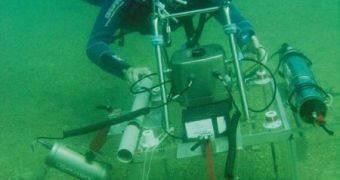Oceanic dead zones are areas in the open sea, or around shorelines, where accumulations of various types of pollutants have caused a massive drop in the number of species living at the location. For example, where rivers bring fertilizers into the water, microbes multiply to such extent that they remove all of the oxygen from the water. This means that more complex organisms can no longer live there. Algal blooms can cause the same effects, as can severe plastic pollution too.
Determining how dead zones evolve and spread, as well as the factors that influence its basic traits, is the goal of a new set of studies, conducted by experts at the University of Vienna, in Austria. The team here is using a small Plexiglas chamber to simulate oxygen deprivation in the open ocean. The test device was placed at the bottom of the Adriatic Sea (a part of the Mediterranean Sea), off the coast of Slovenia. The experimental module had its most important parameters constantly monitored.
“In the lab, you can put an animal into a glass jar and record its reactions to dropping oxygen values. This will tell you very little about what that animal might actually do in the real environment, or what might happen to it in the framework of the surrounding community,” University of Vienna marine biologist and study researcher Michael Stachowitsch tells OurAmazingPlanet in an email. He adds that his team managed to create a “catalog” of behaviors marine life employs when subjected to oxygen deprivation. In the future, the new data could help better inform conservation efforts.
“Today, everyone is talking about bacteria, viruses, genomics, proteomics […] but is knowledge about these things going to save our planet and save us? As interesting intellectually as many of these topics are, my answer is an emphatic 'No',” the expert adds. He says that we need to pay more attention to the way bottom dwelling species and filter feeders develop, as these species are the basis of the food chain, and also the ones keeping the ocean floor clean.

 14 DAY TRIAL //
14 DAY TRIAL //